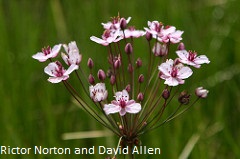|
Invasive - Eradicate!Flowering rush may provide cover for waterfowl, however due to its invasive nature it should be eradicated as it can crowd out native species with higher value to wildlife. |

Problems
Flowering rush was likely brought to North America from Europe. While single flowering rush plants are not a "problem," this exotic can form dense stands which may interfere with recreational lake use. Flowering rush may also crowd out native plants and in turn harm fish and wildlife.
Plant Description:
Flowering rush is a perennial aquatic plant. It grows 1-4' high on an erect stem along shores in shallow water. In deeper water flowering rush grows submerged without producing flowers. Leaves are sword-shaped and triangular in cross section. An umbrella shaped flower head develops producing many seeds that may or may not be viable. Most reproduction is done from its rootstock in the form of bulb-lets.
Flowering rush is very difficult to identify when not in flower. It closely resembles many native shoreline plants, such as the common bulrush.
Hints to Identify
Flowering rush is easiest to identify when flowering. Flowers grow in umbrella shaped clusters and each individual flower has 3 whitish pink petals. Plants only produce flowers in very shallow water or on dry sites.
|
Homeowner Treatment Options
|
| Shoreline Defense® Herbicide/Cygnet Plus Combo |
| *Aquatic Biologists recommends implementing preventative management techniques and physical removal prior to, or in conjunction with treatment. |
Common Application Questions
Q. How much should I treat?
A. The entire population should be treated as flowering rush is not native to the region.
Q. When is the best time to treat?
A. Once water temperatures are around sixty degrees or warmer.
Q. How long before I see results?
A. It really depends on the product you choose. For most vegetation, control will take approximately 2 weeks however, tissue damage may be evident within 2 to 4 days with liquid formulations.

